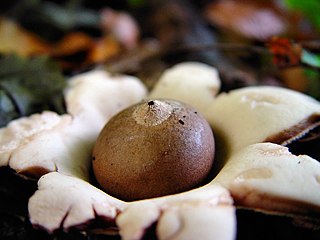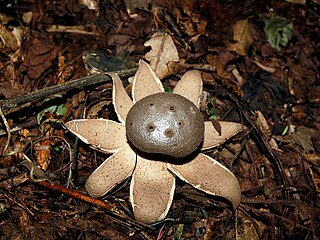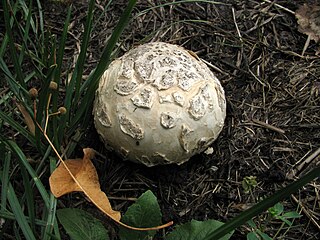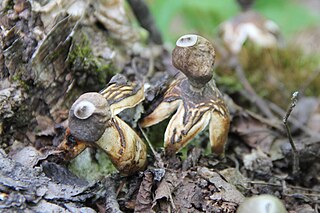
Macrolepiota is a genus of white spored, gilled mushrooms of the family Agaricaceae. The best-known member is the parasol mushroom (M. procera). The widespread genus contains about 40 species.

Geastrum is a genus of puffball-like mushrooms in the family Geastraceae. Many species are commonly known as earthstars.

Calostoma is a genus of 29 species of gasteroid fungi in the suborder Sclerodermatineae. Like other gasteroid fungi, Calostoma do not have the spore discharge mechanism associated with typical gilled fungi (ballistospory), and instead have enclosed spore-bearing structures. Resembling round puffballs with raised, brightly colored spore openings (ostioles), elevated on a thick, gelatinous stalks, species have been collected in regions of deciduous, temperate, tropical or subtropical forests. Their distribution includes eastern North America, Central America, Asia, and Australasia. The common name given to some species, "prettymouth", alludes to the brightly colored raised openings (ostioles) that may somewhat resemble lips. Other common names include "hotlips" and "puffball in aspic".

Podaxis is a genus of secotioid fungi in the family Agaricaceae. Species, which have the appearance of a "stalked-puffball", have a worldwide distribution, and tend to be found growing solitary or scattered on sandy soils, especially in arid regions. Although close to 50 species have been described, it has been argued that many of them may represent extremes in the natural range of variations found in Podaxis pistillaris.

Bovista is a genus of fungi commonly known as the true puffballs. It was formerly classified within the now-obsolete order Lycoperdales, which, following a restructuring of fungal taxonomy brought about by molecular phylogeny, has been split; the species of Bovista are now placed in the family Agaricaceae of the order Agaricales. Bovista species have a collectively widespread distribution, and are found largely in temperate regions of the world. Various species have historically been used in homeopathic preparations.

Myriostoma is a fungal genus in the family Geastraceae. Basidiocarps resemble earthstars, but the spore sac is supported by multiple columns and has multiple ostioles instead of a single, apical ostiole. Until 2017, the genus was thought to be monotypic with a single, widespread species, Myriostoma coliforme. Recent research has, however, shown that at least six species occur worldwide.
Geasteroides is a fungal genus in the family Geastraceae. A monotypic genus, it contains the single species Geasteroides texensis, described by American mycologist William Henry Long in 1917.

Schenella is a genus of fungi in the family Geastraceae. The widely distributed genus contains four species. The genus was circumscribed by Thomas Huston Macbride in 1911. Pyrenogaster, described in 1977, is a later synonym.

Geastrum triplex is a fungus found in the detritus and leaf litter of hardwood forests around the world. It is commonly known as the collared earthstar, the saucered earthstar, or the triple earthstar—and less commonly by the alternative species name Geastrum indicum. It is the largest member of the genus Geastrum and expanded mature specimens can reach a tip-to-tip length of up to 12 centimeters (4.7 in).

Disciseda is a genus of gasteroid fungi in the family Agaricaceae. It is a widely distributed genus that is prevalent in arid zones. Disciseda was circumscribed by mycologist Vassiliĭ Matveievitch Czernajew in 1845.

Mycenastrum is a fungal genus in the family Agaricaceae. The genus is monotypic, containing one widely distributed species, Mycenastrum corium, known by various common names: the giant pasture puffball, leathery puffball, or tough puffball. The roughly spherical to turnip-shaped puffball-like fruit bodies grow to a diameter of 6–24 cm (2–9 in). Initially covered by a thick, felted, whitish layer, the puffballs develop a characteristic checkered skin (peridium) in age. When the internal spore mass, the gleba, is firm and white, the puffball is edible, although some individuals may suffer mild gastrointestinal symptoms after eating it. As the spores mature, the gleba turns first yellowish then purplish brown. Spores are released when the peridium eventually splits open into irregularly shaped sections. Microscopically, the gleba consists of spherical, dark brown spores with rounded bumps on their surfaces, and a capillitium—intricately branched fibers that form long thorn-like spines. The puffball grows on or in the ground in prairie or desert habitats. Although widely distributed, it is not commonly encountered. Mycenastrum corium is a threatened species in Europe.

Lycoperdon echinatum, commonly known as the spiny puffball or the spring puffball, is a type of puffball mushroom in the family Agaricaceae. The saprobic species has been found in Africa, Europe, Central America, and North America, where it grows on soil in deciduous woods, glades, and pastures. It has been proposed that North American specimens be considered a separate species, Lycoperdon americanum, but this suggestion has not been followed by most authors. Molecular analysis indicates that L. echinatum is closely related to the puffball genus Handkea.
Lenzitopsis is a genus of fungi in the family Thelephoraceae. This genus contains two species, the type Lenzitopsis oxycedri and L. daii, described as new to science in 2012.

Geastrum quadrifidum, commonly known as the rayed earthstar or four-footed earthstar, is an inedible species of mushroom belonging to the genus Geastrum, or earthstar fungi. First described scientifically by Christian Hendrik Persoon in 1794, G. quadrifidum is a cosmopolitan—but not common—species of Europe, the Americas, Africa, Asia, and Australasia. The fungus is a saprobe, feeding off decomposing organic matter present in the soil and litter of coniferous forests.

Myriostoma coliforme is a fungal species in the family Geastraceae. Basidiocarps resemble earthstars, but the spore sac is supported by multiple columns and has multiple ostioles instead of a single, apical ostiole. In the UK, its recommended English name is pepper pot. It has also been called "salt-shaker earthstar". The fungus has a north temperate distribution, but was formerly thought to be more widespread due to confusion with related Myriostoma species. Myriostoma coliforme is an uncommon species and appears on the Red Lists of 12 European countries. In 2004 it was one of 33 species proposed for protection under the Bern Convention by the European Council for Conservation of Fungi.













